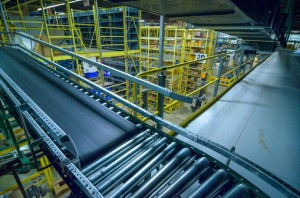Risk, Effort Bring Rewards to Distributor
Pet Age Staff //July 1, 2014//
 The team at Phillips Pet Food & Supplies isn’t afraid to take risks. But, just as importantly, it isn’t afraid of the work needed to make those risks pay off.
The team at Phillips Pet Food & Supplies isn’t afraid to take risks. But, just as importantly, it isn’t afraid of the work needed to make those risks pay off.
The company’s bold approach has helped it grow over the last 76 years, especially as it moved into the distribution business in the 1980s. The Easton, Pa.-based company worked hard to break in and, once it did, kept on making big moves.
“What we’ve always tried to strive for in our company is to have the company positioned so when the next opportunity comes, we can say, ‘Yes,’” said Blaine Phillips, CEO of Phillips Pet Food.
In the early 1990s, for example, Phillips Pet Food seized an opportunity to branch out into Florida, even though its distribution operations then were still centered exclusively in eastern Pennsylvania. Growth has continued in recent years with a string of acquisitions that have made Phillips Pet Food a nationwide distributor.
The opportunities have not just been geographic. In the mid-2000s, a vendor asked Phillips Pet Food to help test a larger distribution system for frozen pet food, said Sheryl Maher, the company’s chief marketing officer. Traditionally, she said, frozen pet food had been distributed in small territories, usually within a 50-mile radius.
Phillips tackled the challenge and eventually made it work, Maher said. Today, the company’s Easton warehouse includes a 3,000-square-foot freezer with a 24-foot ceiling.
“That commitment to doing a great job and developing and sticking with a program until it’s right … benefits us in everything we do,” Maher said.
It’s a commitment on display today as the company rolls out initiatives designed to help both retailers and vendors not just move products, but run more successful businesses.
“If we can make them successful, we know, as a company, we will also be successful,” said Phillips, who is a grandson of the company’s founder.
Ralph O. Phillips. (For the company’s history, see article on page 16.)
Indeed, the company strives to develop value-added services that help its customers survive and thrive in a competitive market. Especially important to Phillips Pet Food are independent retailers. They continue to play an important role, often serving as a consumer’s first entry point into the world of pet products, and as a valuable source of information when a pet’s needs change.
In interviews at company headquarters, Phillips, Maher and a third executive, Fred Schober, discussed the company’s newest initiatives, which include installing an automated conveyor system for assembling orders in its Easton warehouse, and harnessing the power of “big data” to help vendors and independent retailers.
“We want to excel at getting the customer what they want, when they want it, in the condition they expect it,” said Schober, Phillips’ COO. He joined the company in 2010 after it purchased Super-Dog Pet Food Co. in Leola, Pa.
Here is a look at three of the company’s recent initiatives.
Big data descends on pet food
Phillips Pet Food & Supplies is tapping cloud-based software, developed by a company called Birst, to make sense of the information it gathers every day from pet retailers and vendors. The goal is to take that information and use it to make better decisions, company executives said.
It’s analogous to the way “big data” is being used to enhance decision-making in industries around the world, but tailored to the needs of pet retailers and vendors.
“We can supply that data back to help people identify trends they might be missing, product assortments they might be missing or, to expand on that, how to go ahead and position the products in their store better to expand on their sales,” said Schober.
For example, Phillips can determine that a product has 10 percent of the market in one area, meaning it has room to grow. In another area, the Birst software might show that a company has 80 percent market share, leaving little room for expansion.
“Vendors have wanted this for years,” said Maher.
The technology was in development for most of 2013 and was tested in winter 2014, Maher said. Today, sales reps in the field carry the Birst software on iPads and can generate up-to-date reports before meeting with retailers, Maher said.
The technology also can keep up with Phillips’ growth. The distributor has acquired numerous companies over the years, and their data can be entered quickly into the Birst system, Maher said.
Tools help retailers thrive
The iT Kit is a comprehensive marketing platform that builds on Phillips’ position as an intermediary between vendors and smaller retailers. In essence, it is a bundle of tools and programs that independent stores can use to attract new customers, retain existing customers and improve the shopping experience.
Most importantly, it bridges the gap between larger vendors and smaller retailers, allowing retailers to take advantage of vendor marketing initiatives without the vendors having to coordinate efforts with myriad small businesses.
“We saw that our size could be the intermediary to make all this happen,” said Maher.
The iT Kit’s ingredients include:
Mail iT, a program that allows retailers to send direct-mail postcards to targeted consumers in a store’s neighborhood at a reduced cost.
Web iT, a partnership with Pet Store Websites that offers retailers a discount on website creation, content management and social media.
Text iT, a program available through a partnership with Big Oyster and Petz Mobile. It allows retailers to send store and manufacturer offers, via text, directly to consumers’ phones, provided recipients have opted in.
POS iT, offered in partnership with LightSpeed to help retailers who don’t have, or need to improve, point-of-sale systems.
Design iT, a solution through Handy Store Fixtures for retailers
that have fixture, design or layout needs.
Insure iT, a program created by Phillips to offer negotiated savings on insurance.
The Web iT program, in particular, could help retailers compete with the growing number of Internet-based outlets serving the pet food market, according to Phillips Pet Food executives. Retailers can establish a custom website for their customers, and even pick and choose which products appear. Phillips Pet Food will handle the back end of fulfilling orders.
“There is a great deal of excitement,” said Schober. “I think a lot of people are anxious to move forward with it.”
Moving the goods
Step into the Phillips Pet Food Warehouse in Easton, and you will see a brand-new conv eyor system for assembling customer orders. Installed in 2013, the system blends automation and voice technology to improve accuracy.
eyor system for assembling customer orders. Installed in 2013, the system blends automation and voice technology to improve accuracy.
The hardest part of the installation was getting the different technologies involved to communicate, according to Schober. There’s the system guiding the conveyor, made by Dematic; the voice system, developed by Lucas Systems; and the warehouse management system used by Phillips Pet Food.
The 3,500-foot conveyor system winds across a three-floor mezzanine. Along the way, boxes are guided by laser eyes that scan bar-code labels and divert the boxes into the appropriate picking stations. In those stations, workers wearing headsets are guided by the voice system, which tells them what goes in each box.
Once the boxes are ready, they wind down one of five spirals into bays where they are then loaded onto trucks.
“I would have to say we’re really on one of the higher levels of utilizing automated conveyor systems,” Schober said.
If volume warrants, the system could be installed in additional Phillips Pet Food warehouses, Schober added.
Looking ahead
As the new initiatives roll out, leaders at Phillips Pet Food are eyeing what’s next. While predictions may be futile in an industry as dynamic as pet supplies, one thing is clear: Future growth is likely.
“It’s really a $58 billion business today, and we don’t see any reason why that category won’t continue to grow,” Phillips said.
The industry itself expands at a rate of roughly 4 percent to 5 percent a year, and Phillips Pet Food has generally outpaced that, thanks to a mix of organic growth and mergers and acquisitions.
Acquisitions have been part of the company since the 1990s, but the pace has picked up over the last few years. In 2006, Phillips Pet Food opened its third distribution facility. Today, it has 13 warehouses serving territories across the U.S. Recent additions include Valley Pet Supply, Elfland Distribution, Chart Pet Nutrition & Supplies and Royal Pet Supplies.
The goal is not to become the only distributor, Phillips said. Rather, it is to create a more efficient supply chain for customers so they are better able to compete. The company also plans to continue investing back in the business, developing products and services that support both retailers and vendors.
“It’s amazing what we’ve accomplished as a team but we’re not done,” Phillips said. “We think there’s a lot more to do out there.”
-Joel Berg




















